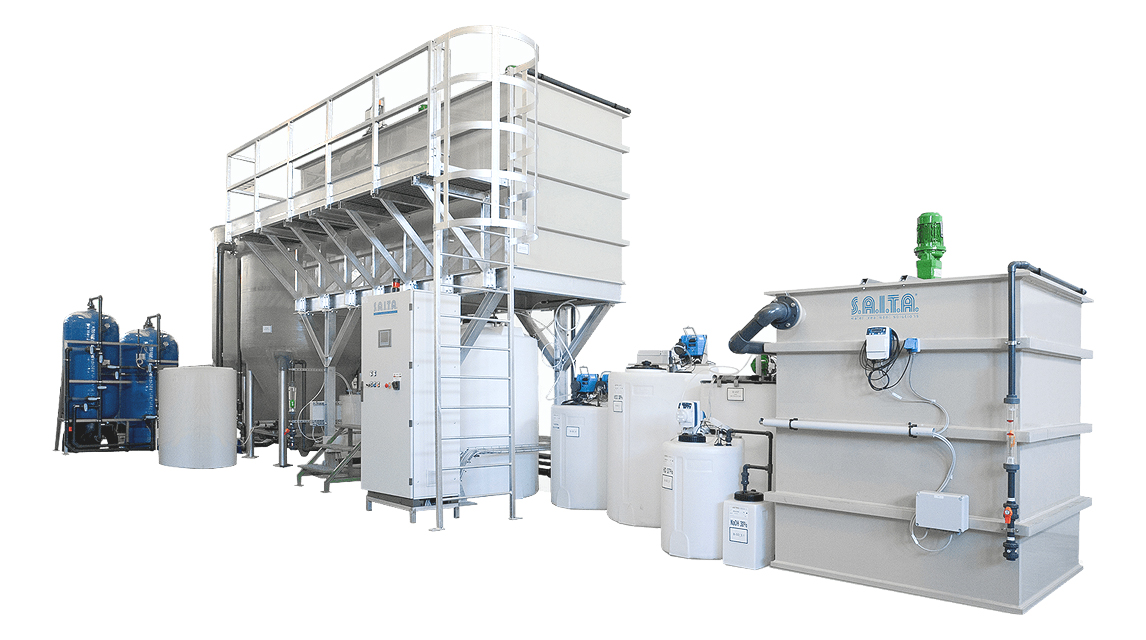Impianti trattamentoACQUE REFLUE
Home
/
chemical-physical-plant


Chemical-physical systems use chemical and physical technologies through various stages in order to remove pollutants in the form of sludge and obtain purified water. The use of particular chemical reagents leads to separation by gravity of substances (mainly metals in the shape of hydroxides and insoluble salts) present in the waste water.
The process consists of a series of more or less complex stages of chemical reaction (acidification, coagulation, alkalinisation and flocculation) followed by a phase of separation of the insoluble fraction (sludge) from the clarified water by sedimentation and followed by the sludge treatment. The cycle is then completed by a further final filtration phase of the treated water before discharging it into the sewage system.
Other treatment sections can be coupled with the traditional types of chemical-physical treatment, such as: Fenton’s reaction for the reduction of organic compounds, cyanide reduction, reduction of Chromium VI to Chromium III and the SAITA DESULFATE Process for the reduction of sulphates and metals.
For water used in wet tumbling (or vibrofinishing) on metal or plastic components (e.g. fashion accessories, jewels and glasses), SAITA proposes chemical-physical treatments that use reagents such as de-emulsifying powders or coagulants for the closed-loop recycling or discharge of purified water.
The CF Series chemical-physical continuous systems are characterized by a separation between diluted and concentrated waste water. Diluted waste water is balanced and sent to the chemical reaction section that includes many tanks in sections where chemical reagents are added. Reactions are controlled with digital instruments for the continuous measurement of the pH (or Redox). The concentrated waste water is stored separately and metered at controlled flow rate to the reaction tanks, to guarantee a balanced flow of pollutants to purify.
The BR Series systems are a batch-type and allow to purify concentrated waste treatment solutions of reduced volume in just one treatment reactor. In fact, the water is loaded into a fibreglass or polypropylene reactor via a pumping station. Inside the reactor, the waste water is mixed and coagulants, alkalizing reagents and flocculants are added, to form a sludge and then solids are separated from liquids. The reaction is controlled with digital instruments for the continuous measurement of the pH (or Redox).
The new DESULFATE chemical-physical process developed for the treatment of waste water contaminated by sulphates, fluorides and heavy metals. The Desulfate process developed by SAITA is designed to solve problems with regard to the discharge limits of sulphates and heavy metals. The process uses a chemical powder additive, D50, that acts together with a dose of limewash in a traditional chemical-physical treatment process. This process, installed in industrial production environments as pickling and coppering of metal wire, aluminium powder-coating and anodizing, allows recycling up to 100% of the water treated.
Innovative chemical-physical process for the reduction of Boron in the treatment of industrial waste water. This process takes place in a traditional chemical-physical system, continuously or in batch. Therefore, the system uses no ion exchange resins or osmosis membranes, but a series of chemical additives, among which the D60 powder, that are dosed proportionally according to the characteristics of the water and the concentration of Boron present. With this process we can obtain a reduction performance down to final concentrations of less than 4mg/l. The main applications are: extraction water, waste treatment centres, polluted ground water, galvanising industry, pharmaceutical industry and glass production.